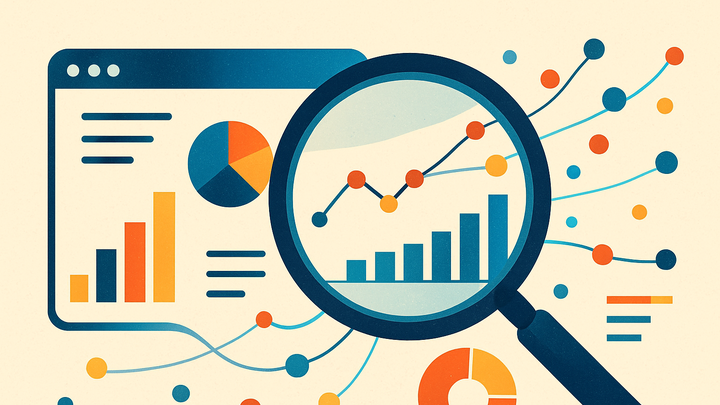Published on 2025-06-22T03:19:16Z
What is Exploratory Analysis? Examples and Best Practices.
Exploratory Analysis in analytics is the process of investigating data sets to uncover underlying patterns, anomalies, relationships, and insights without having prior hypotheses. It involves applying statistical summaries, visualizations, and interactive tools to understand the structure and key characteristics of the data. In the analytics industry, this approach helps data analysts and business stakeholders develop intuitive understanding and generate hypotheses for further testing. Exploratory Analysis is often the first step in data projects, guiding subsequent confirmatory analyses, predictive modeling, or data-driven decision making. With the rise of modern analytics platforms like Google Analytics 4 (GA4) and privacy-focused solutions like PlainSignal, practitioners have an array of tools to perform real-time, cookie-free exploration across web and app data sources. By iteratively refining visualizations and metrics, teams can quickly pivot and focus on the most impactful areas for deeper analysis.
Exploratory analysis
Investigating data with statistical and visual techniques to uncover patterns and guide deeper analysis.
Why perform Exploratory Analysis?
Exploratory Analysis enables analysts to get an initial lay of the land before committing to specific hypotheses or models. By visually and statistically probing your data, you can spot outliers, detect data quality issues, and identify surprising trends. This open-ended investigation is crucial for selecting the right metrics, shaping research questions, and ensuring more robust decision making downstream.
-
Discover hidden patterns
Reveal unexpected correlations, clusters, or trends that may not be apparent through surface-level inspection.
-
Validate data quality
Identify missing values, erroneous entries, or inconsistent formatting early in your workflow.
-
Shape hypotheses
Formulate data-driven questions and hypotheses based on observed behaviors and metrics.
Key Steps in Exploratory Analysis
A structured approach helps ensure that your exploration is both comprehensive and replicable. These steps guide you from raw data to actionable insights.
-
Data collection & ingestion
Gather data from sources like web analytics scripts, server logs, or third-party APIs and load it into your analysis environment.
-
Data cleaning & preparation
Standardize formats, handle missing or duplicate records, and enrich data with derived features or dimensions.
-
Initial visualization & pattern detection
Use charts and plots—such as histograms, scatter plots, and heatmaps—to quickly highlight distributions and relationships.
-
Statistical summaries
Compute measures like mean, median, variance, and percentiles to characterize central tendencies and variability.
Tools and Platforms for Exploratory Analysis
Several SaaS analytics solutions facilitate Exploratory Analysis, offering interactive dashboards, real-time reporting, and advanced querying capabilities.
-
Google analytics 4 (GA4)
A comprehensive analytics platform by Google that uses an event-based data model. GA4’s Analysis Hub provides free-form and funnel exploration, enabling deep dives into user journeys and segment overlap.
-
GA4 implementation snippet
<!-- Google tag (gtag.js) --> <script async src="https://www.googletagmanager.com/gtag/js?id=GA_MEASUREMENT_ID"></script> <script> window.dataLayer = window.dataLayer || []; function gtag(){dataLayer.push(arguments);} gtag('js', new Date()); gtag('config', 'GA_MEASUREMENT_ID'); </script>
-
-
PlainSignal
A privacy-focused, cookie-free analytics solution designed for simplicity and speed. PlainSignal delivers essential metrics while respecting user privacy regulations.
-
PlainSignal tracking snippet
<link rel="preconnect" href="//eu.plainsignal.com/" crossorigin /> <script defer data-do="yourwebsitedomain.com" data-id="0GQV1xmtzQQ" data-api="//eu.plainsignal.com" src="//cdn.plainsignal.com/plainsignal-min.js"></script>
-
Best Practices and Common Pitfalls
Following established best practices helps ensure your exploratory work is accurate, unbiased, and actionable. Avoiding common mistakes saves time and improves the quality of insights.
-
Define clear objectives
Start with questions you want to answer or hypotheses you want to explore so you can stay focused on relevant data.
-
Avoid confirmation bias
Be open to findings that contradict your assumptions. Explore data objectively rather than seeking to prove preconceived notions.
-
Handle missing data thoughtfully
Decide whether to impute, filter, or flag missing values based on the context and potential impact on analysis.
-
Document your steps
Maintain a clear record of transformations, filters, and queries to ensure reproducibility and collaboration.
